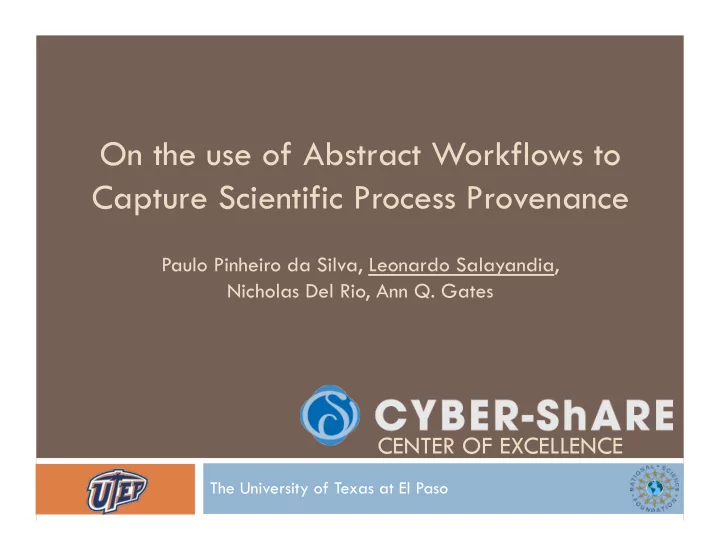

On the use of Abstract Workflows to Capture Scientific Process Provenance Paulo Pinheiro da Silva, Leonardo Salayandia, Nicholas Del Rio, Ann Q. Gates CENTER OF EXCELLENCE The University of Texas at El Paso
Overview Ontologies and Abstract Workflow to document scientific processes The Proof Markup Language (PML) to encode data provenance Capturing provenance about scientific processes Other efforts Conclusions TaPP Workshop – San Jose, CA, February 22, 2010
Documenting Scientific Processes with Ontologies and Abstract Workflows Purpose Identify appropriate vocabulary for a scientific community Model a scientist’s understanding of a process Identify the parts of a process that are of interest to scientists Benefits Share scientist’s understanding of a process with others Guide the development of systems that implement scientist’s understanding of a process Enhance existing systems to provide functionality aligned to scientist’s understanding of a process TaPP Workshop – San Jose, CA, February 22, 2010
Documenting Scientific Processes with Ontologies and Abstract Workflows Phase1: Capture the vocabulary of the process in a Workflow-Driven Ontology (WDO) WDOs have two main classes: Data , e.g., Gridded Dataset, Elevation Map Method Data Outputs is input to Method , e.g., Nearest-neighbor extrapolation Data Method Tool support to construct WDOs Encoded in OWL Reuse vocabulary from other OWL ontologies Generate HTML reports TaPP Workshop – San Jose, CA, February 22, 2010
Documenting Scientific Processes with Ontologies and Abstract Workflows Phase2: Model the process as a Semantic Abstract Workflow (SAW) Dataflow modeling Graphical representation Multiple levels of abstraction supported Tool support to create SAWs Encoded in OWL Generate HTML reports Generate provenance-capturing modules TaPP Workshop – San Jose, CA, February 22, 2010
Documenting Scientific Processes with Ontologies and Abstract Workflows WDOs and SAWs are intended to be authored by Scientists Scientist-centered level of abstraction Dataflow modeling intended to facilitate process modeling TaPP Workshop – San Jose, CA, February 22, 2010
Documenting Scientific Processes with Ontologies and Abstract Workflows Some efforts where WDOs and SAWs are being used Environmental data collection at • La Jornada Experimental Range • The arctic region (Barrow, Alaska) Seismic refraction experiments at Potrillo mountains TaPP Workshop – San Jose, CA, February 22, 2010
Encoding Provenance with PML Proof Markup Language (PML) Derived from the theorem proving community Divided into three parts: PML-Provenance PML-Justification PML-Trust NodeSet Indentified Thing Conclusion With respect to provenance Inference Step Inference … Antecedents Step … NS NS TaPP Workshop – San Jose, CA, February 22, 2010
Encoding Provenance with PML Distributed provenance NodeSets generated by distributed components NodeSets linked through Web conventions Encoded by Encoded by software at software at NodeSet hasAntecendent Laboratory Data Center URI: http://... Encoded by field hasAntecendent NodeSet NodeSet instrumentation URI: http://... URI: http://... NodeSet hasAntecendent URI: http://... TaPP Workshop – San Jose, CA, February 22, 2010
Capturing Scientific Process Provenance The framework: Process and Provenance ontology alignment WDO: Identify things that can be used to document how things can happen (i.e., process) PML-P: Identify things that can be used to document how things happened (i.e., provenance) WDO PML-P Indentified Thing Thing Inference Method Data Information Source Rule TaPP Workshop – San Jose, CA, February 22, 2010
Capturing Scientific Process Provenance The framework: WDO reuses concepts from the PML-P ontology WDO adds properties to the concepts from PML-P WDO vocabulary can be used for Provenance queries! Vocabulary identified by scientist to document process Used to query provenance: Select NodeSets that have an antecedent of type GravityDataset TaPP Workshop – San Jose, CA, February 22, 2010
Capturing Scientific Process Provenance The process of capturing provenance: Goal: Facilitate provenance encoding in PML TaPP Workshop – San Jose, CA, February 22, 2010
Capturing Scientific Process Provenance Automated scientific systems Use process knowledge to generate data annotator modules Instrument system to call data annotators to record provenance during execution E.g., C-shell scripts Use data annotators after system execution to construct provenance from logs/temp files generated by the system E.g., field data-gathering instruments with proprietary software and extensive logging features TaPP Workshop – San Jose, CA, February 22, 2010
Capturing Scientific Process Provenance Manual scientific systems Tool support to encode PML using process knowledge a as template: Technical Report Manually entered parameters TaPP Workshop – San Jose, CA, February 22, 2010
Other Efforts Provenance Query Build RDF triple stores from PML encodings SPARQL queries Provenance Visualization Probe-It! TaPP Workshop – San Jose, CA, February 22, 2010
Conclusions Abstraction is used to comprehensively document scientific processes Encoding provenance in PML is not straight-forward, but tools can help Not all scientific processes are implemented as software systems This approach to document provenance may not be scalable for all systems, but it is useful for some: Scientists building custom systems to gather data TaPP Workshop – San Jose, CA, February 22, 2010
Thank you!
Encoding Provenance with PML More details about PML Divided into three parts: PML-Provenance PML-Justification Indentified PML-Trust Thing Inference Information Source Rule NodeSet Conclusion Agent Document Inference Step Inference … Antecedents Step Person Software Publication Dataset … NS NS TaPP Workshop – San Jose, CA, February 22, 2010
Recommend
More recommend